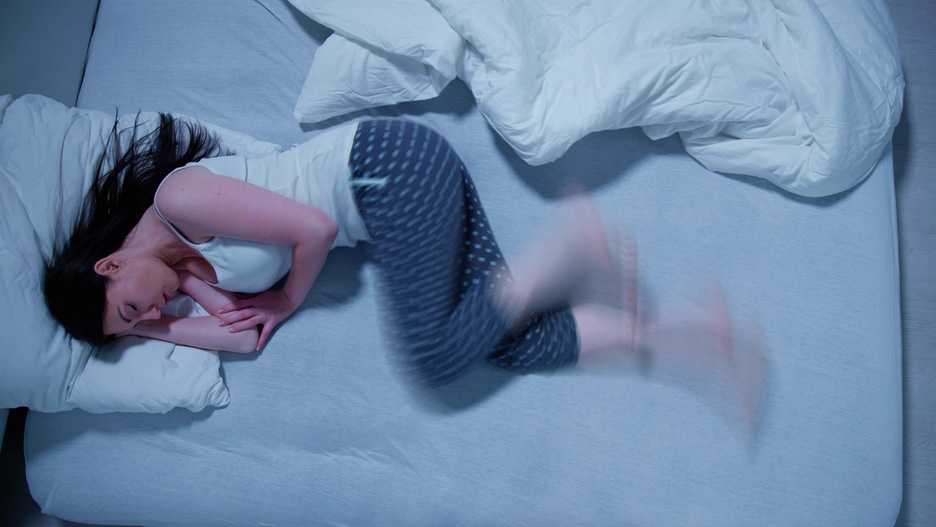Imagine a perfect evening: the gentle warmth of your bed, a calm and soothing atmosphere. You prepare to sink into a deep, restorative sleep… but suddenly, your legs won’t cooperate. An irresistible sensation takes over, you toss and turn, and the micro-awakenings begin to multiply. You’re not alone. Welcome to the mysterious world of Restless Legs Syndrome (RLS), a disorder that shakes up your nights and plunges you into a whirlwind of unpleasant sensations. But don’t worry, this isn’t inevitable. There are solutions to reclaim peaceful nights and sleep as delightful as a waking dream.
Restless Legs Syndrome: An Endless Dance
RLS, this often misunderstood nocturnal disorder, affects 5 to 10% of the population. It’s like an unwelcome guest showing up when you need rest the most. The symptoms are simple yet formidable: an irresistible urge to move your legs, accompanied by strange sensations like itching or tingling. These sensations usually appear when you try to relax, close your eyes, and surrender to sleep.
But why this agitation? Researchers have pinpointed the cause in the brain circuits responsible for controlling movements. Malfunctions in dopamine, a key neurotransmitter, are largely responsible for this uncontrollable urge to move the legs. Not only does this prevent you from falling asleep, but it also triggers those infamous micro-awakenings that disturb your nights.
Micro-Awakings and Fragmented Sleep: An Explosive Cocktail
One of the most insidious aspects of RLS is how it destroys the quality of your sleep. If you thought these little awakenings were harmless, think again. These micro-awakenings act like tiny reminders, waking you just enough to disrupt the natural rhythm of your sleep. The result? You never enter the deep sleep phases where your body truly regenerates.
And that’s not all! Your REM sleep, the phase of dreams that is crucial for emotional balance and memory, is also severely affected. It’s as if your brain never has time to “clear” and “reorganize,” leaving you tired, irritable, and sometimes even a little lost in the morning. Yes, all of this for just a few seconds of uncontrollable movement… How can a simple sensation in the legs cause such a nighttime catastrophe?
The Mysterious Causes: In Search of the Culprit
What causes this mysterious disorder? The reasons are multiple, but several genetic and environmental factors seem to play a key role. RLS is partly hereditary: you are more likely to be affected if your relatives also suffer from it. But that’s not all! Iron deficiencies, which affect dopamine activity in the brain, and certain conditions like kidney failure or diabetes, are also common triggers.
One of the mysteries of this disease is that it can be hard to diagnose because its symptoms sometimes overlap with other sleep problems. But once you identify the cause, it becomes possible to begin unraveling this Gordian knot, thanks to increasingly targeted and effective treatments.
A Sleep Wasted, but Not Without Hope
You’ve probably realized by now: RLS disrupts far more than just your nights; it seeps into your days. Persistent fatigue, mood swings, and difficulty concentrating become daily struggles for those suffering from this disorder. It’s not just a small nuisance; it’s a real wellness headache. But don’t be discouraged! The good news is that there are solutions to restore balance and get back to restful nights.
Current treatments focus on regulating dopamine, the capricious neurotransmitter at the heart of the issue. Dopaminergic agonists like pramipexole or ropinirole are often used to improve symptoms. Additionally, iron supplementation, if a deficiency is detected, can provide tangible relief. It’s also crucial not to neglect lifestyle habits: regular physical activity, stress management, and some dietary adjustments can make a big difference.
One of the greatest assets in fighting this disorder is not hesitating to talk about it and seek appropriate treatment. Since each individual is different, what works for one person may not necessarily be effective for another. It’s about finding the best combination of medications, practical advice, and lifestyle changes to finally regain quality sleep.
A Gentle Return to Tranquility
Imagine for a moment: the softness of your covers, your legs finally at peace, and your body slowly sinking into deep, restorative sleep. RLS, though disruptive, does not have to define your nights. With a little patience and the right support, you can face this disorder and regain sleep as calm as the song of a summer evening. You deserve nights without restlessness, dreams full of promise, and a serene awakening, ready to tackle the day with energy and enthusiasm.
The journey to peaceful sleep begins with a good understanding of what disrupts your nights. And believe it, it is entirely possible to emerge victorious!
Sources :
- ScienceDirect.com, “Restless Legs Syndrome and Its Impact on Daily Functioning“
- NIH, “The Impact of Restless Legs Syndrome on Sleep and Quality of Life“
- NIH, “Restless Legs Syndrome: A Comprehensive Review“
- SageJournals, “Neurobiological Mechanisms of Restless Legs Syndrome“
- ScienceDirect.com, “Iron Deficiency and Dopamine Dysfunction in Restless Legs Syndrome“


